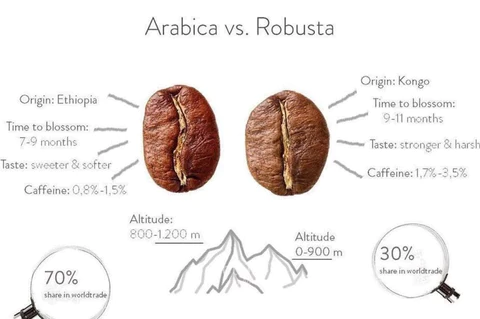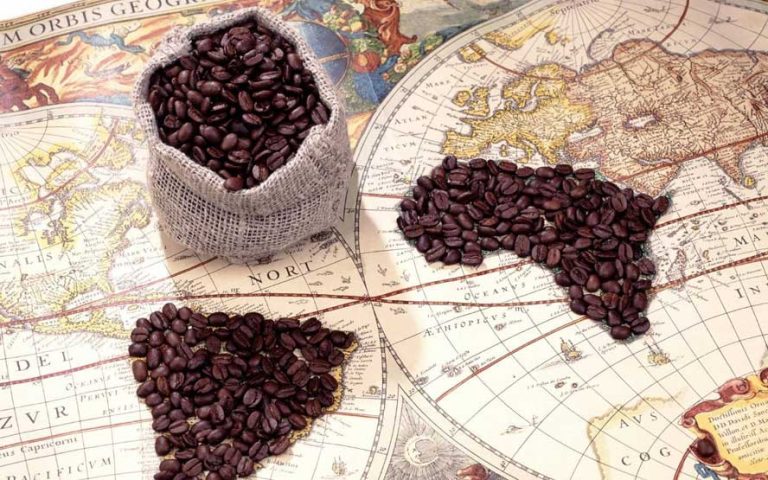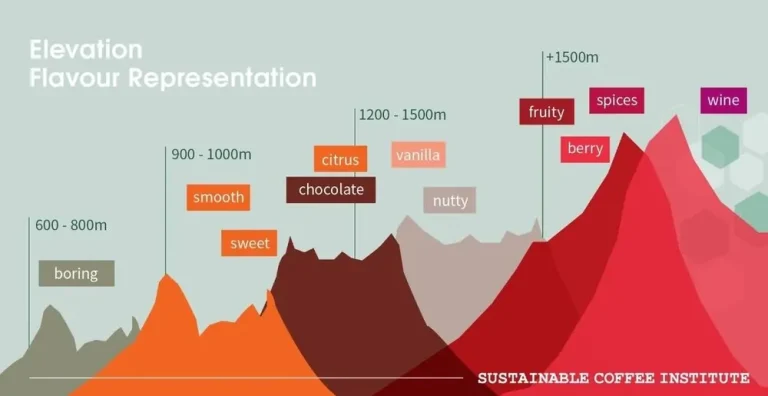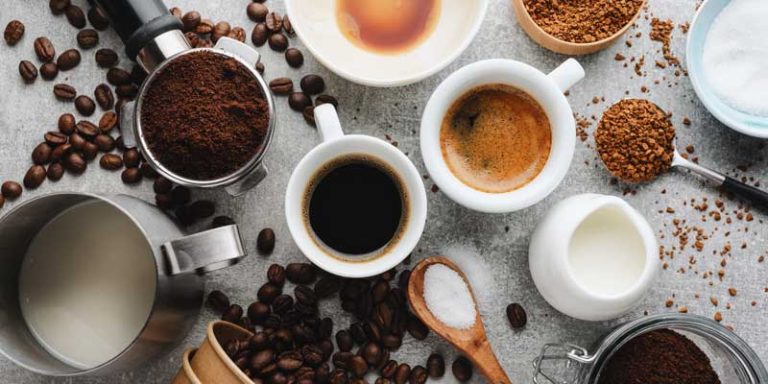Are you a coffee lover looking to deepen your understanding of the different types of coffee beans?
We explore the differences between Arabica and Robusta coffee beans, from their origins and growing conditions to their taste profiles and caffeine content.
Delve into their cultivation and harvesting methods, processing techniques, health benefits, and environmental impact. Join us on a journey through the world of Arabica and Robusta coffee beans to discover the nuances of these popular brews.
Key Takeaways:
1.
- Arabica and Robusta coffee beans have different origins, growing conditions, taste profiles, and caffeine content.
2.
- Arabica is generally considered higher quality with a smoother flavor, while Robusta is more bitter and higher in caffeine.
3.
- The environmental impact of coffee cultivation and processing should be considered when choosing between Arabica and Robusta beans.
Introduction to Arabica and Robusta Coffee Beans
Arabica and Robusta are two primary species of coffee beans cultivated worldwide, each renowned for its distinct taste profile, caffeine content, and cultivation requirements.
Arabica beans are considered more flavorful, with notes of fruit and acidity, making them popular among coffee connoisseurs. On the other hand, Robusta beans are known for their strong, bold flavor and higher caffeine content, making them ideal for espresso blends.
Arabica coffee plants thrive in higher altitudes, requiring specific growing conditions such as shade and consistent rainfall. In contrast, Robusta plants are more robust and can withstand lower elevations, making them easier to cultivate in various regions.
The choice between Arabica and Robusta beans depends on personal preference, with each offering a unique coffee experience based on their distinct characteristics.
Origin and Growing Conditions
Arabica and Robusta coffee beans have distinct origins and thrive in diverse growing conditions, with Arabica predominantly cultivated in high-altitude regions of countries like Colombia and Brazil, while Robusta is commonly grown in lowland areas of Africa and Asia.
Arabica beans are often praised for their complex flavor profiles, which can range from fruity and floral to nutty and chocolaty, making them a favorite among specialty coffee enthusiasts. On the other hand, Robusta beans are known for their bold and bitter taste, often being used in espresso blends for their crema-enhancing properties. The mountainous terrain of regions like Colombia and the rich volcanic soil of Brazil create the ideal environment for Arabica plants to thrive, requiring higher altitudes and cooler temperatures.
Physical Characteristics
The physical appearance of Arabica and Robusta beans varies significantly, with Arabica beans typically being larger and flatter, while Robusta beans are smaller and rounder in shape, showcasing distinct visual characteristics that distinguish the two species.
When examining Arabica beans, they appear elongated and slightly curved, often with a crease running along one side. Their texture is smoother, and the color tends to be a richer shade of green before roasting. On the other hand, Robusta beans are compact and more symmetrical, with a straighter shape. The surface of Robusta beans is bumpier, almost resembling a peanut in appearance. Regarding color, Robusta beans are typically darker in hue compared to the more subtle tones of Arabica beans.
Appearance of Arabica vs. Robusta Beans
When comparing the appearance of Arabica and Robusta beans, one can notice distinct differences in size, shape, and color, with Arabica beans typically larger and flatter, while Robusta beans are smaller and rounder.
Arabica beans tend to have a more elongated shape compared to the roundness of Robusta beans, which can be observed while examining a batch of freshly harvested coffee beans. In terms of color, Arabica beans often exhibit a richer shade of green, sometimes with a bluish hue, while Robusta beans have a darker green color. Another key difference lies in the density, with Arabica beans being less dense than Robusta beans, impacting their flavor and aroma profiles significantly. These differences in physical attributes contribute to the unique characteristics and flavors of the two coffee species.
Taste Profile
Arabica and Robusta coffee beans offer distinct taste profiles, with Arabica known for its smooth, nuanced flavors and Robusta characterized by a stronger, more bitter taste, providing coffee enthusiasts with diverse sensory experiences.
Arabica beans are often favored for their complex acidity, floral and fruity notes, and delicate sweetness, creating a well-balanced cup of coffee. On the other hand, Robusta beans are recognized for their bold and earthy flavors, higher caffeine content, and a thicker mouthfeel, making them popular for espresso blends and instant coffee. When brewed, Arabica coffees tend to have a bright and lively aroma, whereas Robusta brews often carry a more pungent and intense fragrance.
Flavor Differences between Arabica and Robusta
The flavor differences between Arabica and Robusta coffee beans are evident in their taste profiles, with Arabica offering a smoother, more complex flavor, while Robusta boasts a robust, slightly bitter taste that some find invigorating.
Arabica beans are cherished for their delicate acidity and hints of sweetness, often described with floral notes or fruity undertones. On the other hand, Robusta beans are known for their bold, earthy flavor with a stronger, more pronounced bitterness. The acidity in Arabica coffee tends to be higher, presenting a bright and lively zest on the palate, whereas Robusta showcases a more aggressive, almost pungent acidity that can be polarizing.
Caffeine Content Comparison
Arabica and Robusta differ significantly in their caffeine content, with Robusta beans containing almost double the caffeine levels of Arabica beans, making them a popular choice for those seeking a stronger caffeine kick in their coffee.
In terms of coffee strength, caffeine plays a crucial role in determining the intensity of flavor and the impact on your coffee experience. Caffeine is a natural stimulant that can enhance alertness and focus, making it a sought-after component in coffee preferences.
Due to the higher caffeine content in Robusta beans, the resulting brew tends to have a more bitter and potent taste compared to Arabica-based coffees.
Caffeine levels in coffee can vary based on factors such as brewing methods, roast profiles, and serving sizes, influencing the overall strength and flavor profile of the final cup.
Therefore, understanding the caffeine disparities between Arabica and Robusta beans is essential for coffee enthusiasts looking to tailor their coffee consumption based on their desired caffeine intake levels and flavor preferences.”
Price and Availability Variations
The price and availability of Arabica and Robusta coffee beans differ due to factors like quality, cultivation requirements, and consumer preferences, with Arabica often commanding a higher price for its sought-after flavor and Robusta being more readily available for mass production.
Arabica beans are known for their complex flavor profile, often described as smooth, with hints of sweetness and varying acidity levels, making them a favorite among specialty coffee enthusiasts. This intricate taste comes from the beans’ growth at higher altitudes in cooler climates, resulting in a longer maturation process. On the other hand, Robusta beans are hardier and more resistant to diseases, thriving at lower altitudes in warmer environments, which also makes them cheaper to produce.
Cultivation and Harvesting Methods
Arabica and Robusta coffee plants require distinct cultivation and harvesting methods to thrive, with Arabica thriving in higher altitudes with specific care needs, while Robusta tolerates lower elevations and is more resilient to pests and diseases.
Arabica coffee plants are renowned for their need for cool subtropical climates, rich soil, and frequent rainfall, making them well-suited for regions such as the highlands of Ethiopia and Central America.
In contrast, Robusta coffee plants are hardier, thriving in hot, humid conditions common in Southeast Asia and Africa, growing well in lowlands and withstanding challenging weather conditions.
Popularity and Consumption Trends
The popularity and consumption trends of Arabica and Robusta coffee vary regionally, with Arabica being favored for its refined flavors in specialty coffee markets, while Robusta finds extensive use in instant coffee blends and espresso preparations due to its bold taste and lower cost.
Arabica coffee, beloved for its smooth, aromatic profiles, is often the top choice among discerning coffee enthusiasts who value complex taste notes and a mellow finish. This species is commonly linked to single-origin offerings and artisanal brews, appealing to those seeking a more nuanced coffee experience.
On the other hand, Robusta, known for its higher caffeine content and intense, earthy flavors, has carved out a niche in the global coffee industry, catering to those who prefer a strong, full-bodied cup. Its robust nature makes it a popular choice for blending, providing depth and crema in espresso drinks.
Processing Techniques
The processing techniques employed for Arabica and Robusta coffees play a crucial role in shaping the final flavor profiles and qualities of the brewed beverages, with Arabica often undergoing meticulous processing methods to preserve its delicate flavors, while Robusta may undergo more robust processing to enhance its boldness.
Arabica beans are frequently processed using the wet method, where the cherry’s pulp is removed using water, leading to a cleaner and brighter cup with pronounced acidity and floral notes. Conversely, Robusta beans are commonly subjected to the dry method, where the cherries are sun-dried before hulling, resulting in a heavier body, earthy undertones, and a more pronounced bitterness.
Roasting and Blending Practices
Roasting and blending practices for Arabica and Robusta coffees vary based on desired flavor profiles and regional preferences, with Arabica often roasted to lighter profiles to highlight its nuanced flavors, while Robusta is commonly used in blends to provide depth and crema in espresso preparations.
Arabica beans are known for their complex flavors that can range from fruity and floral to nutty and chocolaty, depending on the roasting level. Lighter roasts bring out the bright acidity and intricate flavors inherent in Arabica beans, making them ideal for single-origin brews or specialty blends.
In contrast, Robusta beans are valued for their bold, intense flavors and high caffeine content. They are often roasted dark to develop a strong, bitter taste that can add balance and body to espresso blends, enhancing the overall richness of the coffee.
Health Benefits of Arabica and Robusta
Arabica and Robusta coffees offer distinct health benefits attributed to antioxidants like chlorogenic acid, with Arabica known for its higher antioxidant content and potential protective effects against certain diseases, while Robusta provides a robust caffeine boost and additional antioxidant properties.
Antioxidants in these coffee varieties play a crucial role in combating oxidative stress and reducing inflammation in the body, contributing to overall health and longevity.
Arabica coffee, in particular, is rich in polyphenols which have been linked to lower risk of chronic conditions, such as heart disease and diabetes.
On the other hand, Robusta coffee contains higher levels of caffeine, known for its stimulating effects on the nervous system and improved mental alertness.
Environmental Impact of Coffee Cultivation
The environmental impact of coffee cultivation, especially Arabica and Robusta farming practices, is a critical consideration for sustainable coffee production, with efforts focused on minimizing deforestation, promoting biodiversity, and supporting eco-friendly growing techniques.
One of the key challenges in Arabica and Robusta coffee cultivation is the risk of habitat destruction due to unsustainable farming methods. Issues such as chemical run-off, soil degradation, and water pollution can arise from intensive agricultural practices. By implementing sustainable agriculture initiatives such as agroforestry, organic farming, and water conservation measures, coffee producers can mitigate these negative impacts on the environment. Through conservation efforts that include preserving natural ecosystems, protecting wildlife habitats, and reducing greenhouse gas emissions, the coffee industry is striving towards a more environmentally friendly and sustainable future.
Dispelling Common Myths about Arabica and Robusta
Dispelling common myths about Arabica and Robusta coffee varieties is essential to foster a deeper understanding of their unique qualities and dispel misconceptions that may overshadow their distinct merits and contributions to the world of coffee.
There is a widespread misconception that Arabica coffee is always of higher quality compared to Robusta. While Arabica is known for its nuanced flavors and aromatic profile, Robusta should not be underestimated. Robusta beans have a higher caffeine content and distinct earthy, bold flavors, making them ideal for espresso blends to provide a rich crema. Misconceptions about Robusta being inherently bitter overlook the fact that proper cultivation and processing methods can enhance its taste profile.
Optimal Uses for Arabica and Robusta Coffee
Identifying the optimal uses for Arabica and Robusta coffees is essential for enhancing coffee experiences, with Arabica favored for its specialty brews like pour-over and drip coffee, while Robusta excels in espresso blends and as an ingredient in robust coffee beverages.
Arabica beans, known for their smooth and flavorful profile, are perfect for slow extraction methods like French Press or siphon brewing, as their delicate nature allows for a nuanced taste experience. On the other hand, Robusta beans are prized for their high caffeine content and bold, bitter flavor, making them ideal for creating intense espresso shots or in blends to add depth and crema. The strong character of Robusta also makes it a popular choice for traditional Vietnamese coffee or Turkish coffee, where a rich and potent beverage is desired.
Key Takeaways and Conclusion
Arabica and Robusta coffee beans offer a spectrum of flavors, caffeine strengths, and cultivation nuances that cater to diverse coffee preferences, making them integral components of the global coffee industry with unique contributions to the richness of coffee culture.
Arabica, known for its delicate taste notes and higher acidity, is often considered the more aromatic and flavorful of the two main coffee species. On the other hand, Robusta, with its stronger and earthier profile, is valued for its higher caffeine content and ability to add body and crema to espresso blends.
- Arabica beans are typically grown at higher altitudes, requiring specific climate conditions, while Robusta thrives in lower elevations with a greater resistance to pests and diseases.
- Arabica beans are favored for specialty coffee due to their complex flavor profiles, whereas Robusta is commonly used in instant coffee and espresso blends.
- The unique characteristics of both beans stem from their different genetic makeup, terroir influence, and processing methods, contributing to the diversity in coffee offerings worldwide.
Frequently Asked Questions (FAQs)
For those seeking quick answers and insights into Arabica and Robusta coffee beans, here are some frequently asked questions and informative responses to deepen your understanding of these two popular coffee varieties.
- What is the main difference between Arabica and Robusta beans?
Arabica beans are known for their delicate flavors with hints of fruit and caramel, while Robusta beans are more robust and bitter with a stronger, earthy taste. - Where are Arabica and Robusta beans typically grown?
Arabica beans thrive in higher altitudes and are mainly grown in Latin America, Africa, and Asia. On the other hand, Robusta beans are more resilient, often cultivated in lowland regions, especially in Africa and Southeast Asia. - What are the health benefits of drinking Arabica and Robusta coffee?
Both types of coffee beans contain antioxidants and caffeine, which may boost energy levels, improve mental alertness, and provide some protection against certain diseases. - How do the taste profiles of Arabica and Robusta coffee differ?
Arabica beans are favored for their smooth, complex flavors, while Robusta beans are known for their strong, bold taste and higher caffeine content. - Can Arabica and Robusta beans be blended together?
Yes, coffee blends often combine Arabica and Robusta beans to achieve a balanced taste profile with varying flavor nuances.
Frequently Asked Questions
What is the difference between Arabica and Robusta coffee beans?
Arabica and Robusta are two types of coffee beans that come from different species of coffee plants. Arabica beans are considered to be of higher quality and have a more complex flavor profile, while Robusta beans are known for their stronger and more bitter taste.
Where are Arabica and Robusta coffee beans grown?
Arabica beans are primarily grown in countries with high altitudes and mild climates, such as Ethiopia, Colombia, and Brazil. On the other hand, Robusta beans are commonly grown in lower altitudes and can thrive in hotter and more humid climates, such as Vietnam, Brazil, and Indonesia.
How do Arabica and Robusta coffee beans differ in terms of caffeine content?
Arabica beans contain about 1.2% caffeine, while Robusta beans have a higher caffeine content of about 2.2%. This means that a cup of Robusta coffee will have almost double the amount of caffeine compared to a cup of Arabica coffee.
Which type of coffee bean is more expensive?
Arabica beans are generally more expensive than Robusta beans, as they require specific growing conditions and are more susceptible to diseases. This leads to a higher production cost and a higher price for Arabica coffee in the market.
Do Arabica and Robusta coffee beans taste different?
Yes, Arabica and Robusta beans have distinct flavor profiles. Arabica beans are known for their smooth, sweet, and fruity taste, while Robusta beans have a stronger and harsher taste with notes of chocolate and nuts.
Can Arabica and Robusta coffee beans be blended together?
Yes, many coffee blends contain a mixture of Arabica and Robusta beans. This allows for a balance of flavor and caffeine content in the final product. However, some coffee purists believe that blending the two types of beans can compromise the quality of the coffee.






